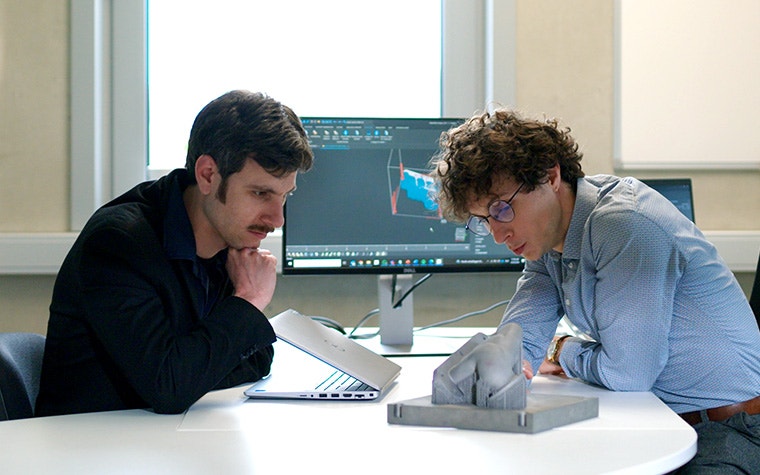EXPERT INSIGHT
Change Your Mindset: How Automating Metal Support Generation Can Help You Avoid the Most Destructive Phrase in AM

Additive manufacturing (AM) is an amazing technology that makes the impossible, possible. It allows manufacturers to produce complex designs with geometries that would be impossible to replicate with traditional manufacturing techniques. However, AM is not perfect. Sometimes, you’ll need to overcome specific challenges to reap its many benefits, especially when dealing with metal 3D printing. But how you answer one little question can impact your production more than any physical task you must undertake. What’s the question? Well, it’s usually: “Why do you produce your part that way?” Nine times out of ten, the response is simply, “Because that’s how we’ve always done it…”
Change your mindset series
While this timeless question usually bewilders or agitates machine operators the world over, their answer may be more harmful than you think. This adherence to traditional methods can have major consequences for your metal AM production, and it’s potentially costing your business hundreds of thousands or even millions of dollars per year in lost revenue — often to the dismay of your CFO. How, you may ask? Due to inefficient workflows, employee skill gaps, and excess material consumption.
In this short article series, we’ll explore each root cause in more detail and see how automation in AM support generation software like Materialise e-Stage for Metal+ can alleviate these issues. Changing your mindset and using such a solution is crucial to creating better builds, more efficient supports, greater efficiency for workflows and material consumption, and lowering the barrier to entry for machine operators working on metal builds.
Explore the other articles in the series:
How automation improves your workflows
“If it ain’t broke, don’t fix it” is an idiom we all know and love. Unfortunately, it’s not the path that leads to innovating and scaling AM or your metal 3D printing production.
“I spoke to a customer unfamiliar with AM, and he said that he’d investigated the rules and regulations around design for additive manufacturing, or DfAM. He concluded that he’d only be able to print 10% of what his company needed,” says Ian O'Loughlin, Metal Technology Practice Lead at Materialise Software. “I believe the thought process of sticking rigidly to DfAM is detrimental to our industry. Obviously, it’s important, but you can bend the rules if you have the right software at your disposal. It all depends on where the iteration process starts in your workflow and whether you can automate it, along with other steps, of course.”
Typically, companies use a standard metal workflow where the iterative process is at the end.
Option 1: a standard metal workflow — multiple iterations (five, six, or more)

The benefits of this workflow are that it’s tried and tested, and no automated software is required. However, there are numerous drawbacks:
- You need experienced employees
- Post-processing is quite demanding and costly
- Multiple print iterations are necessary to gain the appropriate accuracy for your 3D-printed part
“Most companies spend enormous time and money getting to the stage where something works. They don’t want to give that up,” says Ian. “And if you have decades of experience and find something that works through trial and error, you want to stick with it, even if it takes four or five print iterations. But this way of thinking is cost-prohibitive; it’s an expensive lesson to learn for organizations — especially if you’re printing with titanium, stainless steel, or Inconel,” he continues
Option 2: simulation workflow — two or three iterations

Adding a simulation step to the workflow improves the process by allowing users to simulate and iterate before printing, resulting in parts with greater accuracy and fewer print iterations. Also, inexperienced staff can handle metal 3D printing, while post-processing becomes faster and cheaper.
Yet, despite the simulation workflow having more advantages than its predecessor, it’s also time-consuming to perform multiple simulations and iterations. Additionally, manual editing is required, and you need simulation software to run this step in your metal 3D printing workflow.
So, what’s the solution?
Option 3: automation workflow — usually one iteration

The sweet spot uses AM software that automates complex parts like simulation, iteration, and even support generation steps, such as e-Stage for Metal+.
“With block or CAD-designed support, you can reach five or more iterations. Also, they generally increase with complexity, as the more experience you gain, the more intricate your designs tend to be,” explains Ian. “But then we introduced the standard e-Stage module with simulation, and we noticed customers needed around two or three iterations for the same parts, particularly for serial production. Now, with e-Stage for Metal+ and the inclusion of automation, the tool has further optimized the process, resulting in one, or occasionally two iterations at most.”
Reducing the iterative process can cut costs and bring significant ROI to your 3D printing operations. “To provide some concrete figures, I had a customer struggling to produce high-quality parts,” says Chris Jastrzembski, Regional Account Manager at Materialise Software North America. “After implementing e-Stage for Metal+, he mentioned, during a recent follow-up call, that he had shipped $700,000 worth of parts this month alone.”
Changing your mindset is a powerful tool — along with automation
As you can see, shifting your mindset and embracing new technology like support generation software can save you money, time, and effort when processing metal AM builds, even if it might sound scary or risky. In our next article, we’ll discuss how automation benefits your workforce, from newcomers to seasoned professionals, and improves your production methods.
Share on:
You might also like
Never miss a story like this. Get curated content delivered straight to your inbox.
